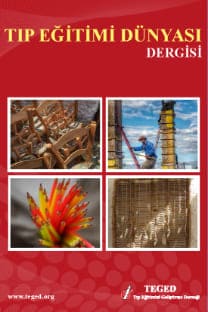Hastane Öncesi̇ Sağlık Profesyonelleri̇ne Yöneli̇k Travma İleri̇ Yaşam Desteği̇ Eği̇ti̇m Programı
AmaçÇalışmanın amacı, hastane öncesinde karşılaşılma ve ölüm oranı yüksek vakalar arasında yer alan travmaya, daha etkili, doğru ve acil müdahale edebilmek için, öğrenen merkezli, küçük grup çalışması içeren, uygulama ve simülasyon ağırlıklı, gerçek yaşam ortamlarıyla uyumlu, öğrenenlerin uzak transferini kolaylaştırmayı, yaşam boyu öğrenmeyi içselleştirmeyi amaçlayan bir eğitim programı olarak hayata geçirilen “Travma İleri Yaşam Desteği Eğitimi (TİYDE) ”nin tanıtılmasıdır.Gereç ve YöntemAraştırmada inceleme materyali olarak Haziran-Ekim 2015 zaman aralığında 89 katılımcı ile 4 kez uygulanan TİYDE ele alınmıştır. İstatistiksel analizler için IBM Statistical Package for the Social Sciences (SPSS) 21.0 kullanılmıştır. Ön-test, son-test ve uygulama sınavları için frekans dağılımları hesaplanmış, karşılaştırmalı analizler için ki-kare testi uygulanmıştır. Bulgularİstatistiksel bulgularda; her kurs için uygulama sınavlarındaki task gruplarına yönelik başarı oranları, ön-test ve son-test ortalamaları, kurslar arası uygulama sınav sonuçları ve cinsiyete göre ön-test, son-test ve uygulama sınavları karşılaştırılmıştır.Sonuç TİYDE programı, ülkemizde 4C-ID yöntemi kullanılarak tasarlanmış ilk eğitim programıdır. Karmaşık beceri öğretiminin hedeflendiği 4C-ID öğretim tasarımı modelinin şablonu travma eğitiminin içeriği ve amacıyla bire bir örtüştüğü için başarılı ve etkin bir eğitim programı ortaya çıkmıştır. Travma eğitiminde ve diğer karmaşık öğrenme gerektiren beceri eğitimlerinde 4C-ID yönteminin kullanıldığı başka çalışmalara da gereksinim vardır.
Anahtar Kelimeler:
Hizmet içi eğitim, profesyonel eğitim, ileri yaşam desteği, eğitimsel değerlendirme
Trauma Advanced Life Support Training Program For Prehospital Health Professionels
Background: Trauma is one of the most encountered and fatal cases in prehospital area. The objective of this study is the evaluation of the “Trauma Advanced Life Support Training (TALST)” which is a learner focused, little group study natured, practice and simulation predominated training program implemented to aim interfering trauma, facilitating the far transfer of the knowledge of the learners and internalizing life time learning.Methods: TALST which was implemented 4 times in the time period between June-October 2015 with 89 participants were included as investigation material. IBM Statistical Package for the Social Sciences (SPSS) 21.0 were used as statistical analyses. Frequency distribution were calculated for pre-test, post-test and pratic examination. Chi square test was used for comparing analysis.Results: In statistical analysis, there were significant diversities in all success rates of pretest and post-test means of the four courses. The lowest post-test success rate mean of all courses was over 85 which is the official success limit.Conclusions: TALST is the first 4C-ID designed training program in our country. Due to the one by one correspondence of trauma training by the pattern of 4C-ID educational design model purposed for complex learning, a succesful and effective training program occured.
Keywords:
Inservice training; professional education, advanced life support, educational assessment, competency-based education,
___
- 1. Paterson, J. G. How Regional Trauma Systems Improve Outcomes? Emergency Nurse 2015;23(6):24–9.
- 2. http://www.tuik.gov.tr/PreHaberBultenleri.do?id=18855 (Erişim tarihi 07.04.2015).
- 3. Häske, D., et al. The effect of paramedic training on pre-hospital trauma care (EPPTC study): a study protocol for a prospective semi-qualitative observational trial. BMC Medical Education 2014; 14(1), 32. doi:10.1186/1472-6920-14-32.
- 4. Doumouras, A. G., Keshet, I., Nathens, A. B., Ahmed, N., & Hicks, C. M. Trauma Non-Technical Training (TNT-2): the development, piloting and multilevel assessment of a simulation-based, interprofessional curriculum for team-based trauma resuscitation. Canadian Journal of Surgery. Journal Canadien de Chirurgie 2014; 57(5), 354–5. doi:10.1503/cjs.000814
- 5. Ziesmann, M. T., Widder, S., Park, J., et al. S.T.A.R.T.T.: development of a national, multidisciplinary trauma crisis resource management curriculum-results from the pilot course. The Journal of Trauma and Acute Care Surgery 2013; 75(5), 753–8. doi:10.1097/TA.0b013e3182a925df
- 6. http://www.resmigazete.gov.tr/default.aspx# (Erişim tarihi: 28.01.2014)
- 7. Erdil, F., Başer, M., Kaya, H., Özer, N., Duygulu, S., & Orgun, F. Hemşirelik Ulusal Çekirdek Programı (HUÇEP). HEMED, 2014.
- 8. Vandewaetere, M., Manhaeve, D., Aertgeerts, B., Clarebout, G., Van Merriënboer, J. J. G., & Roex, A. 4C/ID in medical education: How to design an educational program based on whole-task learning: AMEE Guide No. 93. Medical Teacher 2014; 1–17. doi:10.3109/0142159X.2014.928407
- 9. Van Merriënboer, J. J. G., Clark, R. E., & de Croock, M. B. M. (2002). Blueprints for complex learning: The 4C/ID-model. Educational Technology Research and Development 2002; 50(2), 39–61. doi:10.1007/BF02504993.
- 10. Van Merriënboer, JJG, Kirschner PA. Ten steps to complex learning. 2nd Rev. ed. New York: Routledge 2013.
- 11. Van Merriënboer, J.J.G., Jelsma, O., & Paas, F.G.W.C. Training for reflective expertise: A four-component instructional design model for training complex cognitive skills. Educational Technology Research and Development 1992; 40(2), 23–43.
- 12. Jonassen, D. Thinking technology: Toward a constructivist design model. Educational Technology1994; 34(4), 34–37.
- 13. Van Merriënboer, J. J. G., Clark, R. E., & de Croock, M. B. M. Blueprints for complex learning: The 4C/ID-model. Educational Technology Research and Development 2002; 50(2), 39–61. doi:10.1007/BF02504993.
- 14. http://www.resmigazete.gov.tr/default.aspx# (Erişim tarihi: 28.01.2014)
- 15. http://www.saglik.gov.tr/HM/belge/1-2481/eski2yeni.html (Erişim tarihi: 28.01.2014)
- 16. Göksu, İ., Özcan, K. V., Çakır, R., & Göktaş, Y. Türkiye’de Öğretim Tasarımı Modelleriyle İlgili Yapılmış Çalışmalar. Elementary Education Online 2014; 13(2), 694–709.
- ISSN: 1303-328X
- Yayın Aralığı: Yılda 3 Sayı
- Başlangıç: 2000
- Yayıncı: Tıp Eğitimini Geliştirme Derneği
Sayıdaki Diğer Makaleler
Ali Ramazan BENLİ, Habibe İNCİ, Aybala CEBECİK, Didem SUNAY
Özlem MIDIK, Levent GÜNGÖR, Füsun A. ARTIRAN İĞDE
Fizyoloji Eğitiminde Öğrenci Uygulamalarının Mevcut Durumunun İrdelenmesi ve İyileştirme Önerileri
Hastane Öncesi̇ Sağlık Profesyonelleri̇ne Yöneli̇k Travma İleri̇ Yaşam Desteği̇ Eği̇ti̇m Programı
Okan OK, Kevser VATANSEVER, Ebru ŞENER ARAZ, M. Haluk AGAH, H. İbrahim DURAK
KBB Asistan Eğitiminde Standardizasyon Paneli: Uzmanlık Öğrencileri ve Eğiticilerin Görüşleri
Cüneyt Orhan KARA, Mustafa Daloğlu
Multiprofesyonel Eğitim: Avantajlar, Zorluklar ve Program Geliştirme Önerileri.
Simüle hastalar: onları ne motive eder ve ihtiyaçları nedir?
Tamer Edirne, Serdar Özdemir, Cüneyt O. Kara
